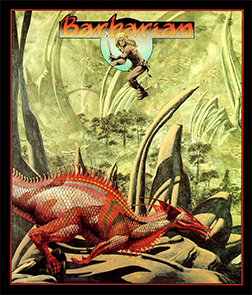| Barbarian | |
|---|---|
 Artwork by Roger Dean. | |
| Developer(s) | Melbourne House |
| Publisher(s) | Psygnosis |
| Platform(s) | Amiga, Amstrad CPC, Atari ST, Commodore 64, DOS, ZX Spectrum |
| Release | 1987 |
| Genre(s) | Platform game |
| Mode(s) | Single player |
Barbarian is a 1987 computer platform game by Psygnosis. It was first developed for the Atari ST, but eventually ported to other popular platforms of the home computer era. Like most early Psygnosis titles, the cover artwork (part of "Red Dragon" figure/landscape) was by the popular fantasy artist, Roger Dean.
Description

The game opens with a striking—for the era—animation of a muscle-bound barbarian cutting a chain with a sword. On the Amiga and Atari ST versions, the animation is accompanied by a loud digital sound effect, showcasing the advanced systems' multimedia capabilities.
In the game, the player is Hegor, a barbarian who must traverse several dungeons and underground habitats to defeat his brother, the evil sorcerer Necron. He has a sword and bow in his arsenal of weapons. Running and jumping, as with many platform games, comprises a large part of the gameplay of this title.
The game used a unique control system to make up for lack of more than one joystick button on many systems. The player would first press the one button after which a "menu" of actions would appear along the bottom of the screen. The player then selected the desired action by cycling through the choices with the joystick and then pressing the button again when the desired action was highlighted.
In the original versions, this game tried to emulate the visual style of the game cover and opening animation. The game used very detailed and colorful sprites and a variety of thoughtful sound effects to accompany the onscreen action. The DOS version played digitized speech in the opening sequence and featured other sound effects using the PC speaker.
Ports
From the Atari ST, the game was ported to the Amiga, Commodore 64, DOS, MSX, Amstrad CPC and ZX Spectrum. The release year for the ports was 1988, except for the Amiga version which was also released in 1987 with the Atari ST version.
Sequels
The game spawned a 1991/1992 sequel, Barbarian II. released alongside Leander, and Ork', other platform-based action-adventures from Psygnosis.
Reception
The game was reviewed in 1989 in Dragon #150 by Courtney Harrington in "The Role of Computers" column.[1]
References
- ^ Lesser, Hartley, Patricia, and Kirk (October 1989). "The Role of Computers". Dragon (150): 68–73, 95.
((cite journal)): CS1 maint: multiple names: authors list (link)